5 Home Improvement Pros Share Lead-Gen Hits, Misses, and Maybes
There is no one perfect way to generate leads. Talk to five different home improvement marketing pros and you’ll get five different answers and five very different figures for marketing budgets and cost-per-lead.
What works for one (say, direct mail) doesn’t work for another. Digital media—some are all in, while others are having remarkable success with print and even radio. One sees weirdness in the market while another sees normalcy.
The commonality is that each found a lead-gen strategy that works for their business.
With that in mind, here is a snapshot of what’s working—and what’s not—for five different home improvement companies.
Jay Shah, Director of Marketing, Bath Experts
In a nutshell: Marketing Budget is 15% of total revenue
Lead generation hasn’t been a problem for Jay Shah since he joined Bath Experts as director of marketing earlier this year. Leads for the Indianapolis-based company increased a whopping 50-70% during the past six months. Shah is quick to offer a caveat: “We weren’t taking advantage of every single lead source out there, so a lot of that is from low hanging fruit.”
One channel he pursued was running campaigns in legacy media: newspapers, magazines and marriage mailers, among them. “Traditional media is shrinking, but it’s still viable enough for us to continue investing in it,” he says.
Another area that’s worked very well for Shah is direct mail, but it’s costly. “You need to have a high enough close rate and average ticket to justify the spend because it is really expensive to get someone to call in from direct mail,” he says.
The marketing budget for Bath Experts is around 15% of revenue generated, and Shah notes that going much higher might indicate a problem.
Traditional media is shrinking, but it’s still viable enough for us to continue investing in it.
For him, one such problem was television. After reviewing the “astronomical” cost Shah felt that he could no longer justify the expense even after allowing for the fact that a presence on TV might bolster other areas as well. “I stopped TV in April and we have not seen a noticeable dip in any of the other channels,” Shah says.
Another problem is market saturation. Shah notes that there are a lot of home improvement companies competing in his area, and lead aggregators are taking advantage of that. “We’re all bidding against each other to generate leads, and there are lead vendors with bidding models that pit companies against each other, and you get to the point where suddenly lead costs are completely outrageous,” he says. In response, Shah decided to work with a single lead provider —which he understands is a gamble. “My costs are low enough to where I’m making it work, and I don’t take the bait when they say that I can increase my cost-per-lead to get more leads. I don’t want to give them a reason to continue jacking up my costs,” he says.
Also getting more expensive is paid search, and Shah notes that he’s cut back because the cost-per-click for Google ads is getting out of control and he hasn’t noticed much improvement in the lead quality.
Summing up his lead generation strategy, Shaw says it’s simply testing, investing, and resting. “You’re testing new partners, you’re investing in the ones that work, and then you’re resting the ones that don’t.”
Ryan Shutt, CEO, Southwest Exteriors
In a nutshell: Cost per lead is close to $600, up from $400-$450 last year.
Lead generation had always seemed predictable to Ryan Shutt, CEO of Southwest Exteriors in San Antonio, until it wasn’t. “Things are weird now. I’m not noticing any common trends,” Shutt says. He attributes part of the changing landscape to COVID, but as for the rest: “If I could figure it out, I’d be super happy,” he says.
In response, over the last three years Shutt’s marketing took a hard turn as he dropped some formerly predictable lead generation channels. “We don’t do canvassing, we don’t do shows and events, and we don’t do anything with aggregators,” he says.
Instead, Shutt now focuses more on digital media. “We made a shift away from one-call closing and ‘really big offers’ to focus on educating the client and dominating digital.”
We don’t do canvassing, we don’t do shows and events, and we don’t do anything with aggregators.
That domination looks like a laser focus on organic search with SEO tactics and content creation as the prime means to drive those numbers.
Still, Shutt maintains a healthy paid search budget because he’s competing in a crowded market. “Those clicks are astronomically expensive because we have so much competition in our space.”
The company employs a full-time writer and videographer who produce three new articles each week and two or three short videos.
Shutt utilizes video content in another capacity as well—personalized messages from his call center. “We use a low-cost platform called Quickpage. Our call center staff have little whiteboards at their desk and they’ll write a personalized note and record a 30-second video and suggest related articles that we created. Our engagement rate is very high with those videos.” For leads that don’t convert, the call center will follow up with a personalized video reminding them that they’re there to help. Shutt says that the ROI on those pieces are off the charts.
Like Shah, another successful area for Shutt is direct mail. Anyone who visits Southwest Exterior’s website, and matches the demographic, but did not convert, gets a mailing within a few days of their visit. The company also sends out pieces three or four times per year to previous clients.
Shutt says his cost-per-lead across all channels is close to $600 (up from $400-$450 last year) with marketing accounting for about 12% of his budget. However, for 2025, he expects to allocate closer to 14%. “It’s hard to predict weirdness,” he says.
Bridget Cramer, Director of Marketing, Lindus Construction
In a nutshell: Bridget Cramer, Director of Marketing for Lindus Construction in Minneapolis, says her prospect to conversion rate is 92%. “We have really good lead sources, and I’ve got a strong team that’s really diligent with converting them,” she explains. Even more surprising numbers: her cost per lead averages $100 and marketing costs are about 2%. “I understand that a lot of people are shocked when they hear those numbers, but we haven’t raised our marketing budget in the 12 years I’ve been here.”
It helps that the family-owned firm has a sterling reputation. “We have a really strong brand, so we can focus on lower-cost items and don’t have to spend as much on leads,” Cramer says.
That strong brand recognition and reputation has paid off in referrals—another low-cost lead channel—and one that accounts for a third of Lindus’ new customers. The company’s customer repeat ratio is huge, as well. “You need to be cognizant of your reputation and get reviews. People want to hear you’re the best, but they don’t want to hear it from you,” she says.
Customers have done their research about you before they even fill out a form, so your content needs to keep hammering on things that they care about.
Lindus’ vast array of digital content includes hundreds of blogs and YouTube videos totaling more than two million views. They’re also popular on Pinterest with more than 50,000 monthly views. “We want to set ourselves up to be an expert and a reliable source for information,” Cramer says. “I read that about 80% of potential customers have done their research about you before they even fill out a form, so your content needs to keep hammering on things that they care about.”
Photography and videography are handled in-house by the CEO’s son, Noah (a third-generation Lindus). The company used to contract with photographers and videographers, but Cramer says that turnaround times were long and it was hard to get someone to a job site to shoot.
The company took another big digital dive this year, redoing all of its landing pages and adjusting content to improve SEO. “The Google platform is changing so fast, changing their rules, so we really put on a full court press,” Cramer says, noting it was heavy lift that’s paying off in more and better leads.
Cramer has retired some big-ticket lead channels, including television, print ads and most direct mail. They run a robust and low-cost email marketing program, though, that is used to stay in touch with past and potential customers.
One of the biggest payoffs for lower lead costs: Lindus Construction doesn’t have to raise their prices. “Not having exorbitant lead costs means we don’t have to pass that on to customers,” Cramer says.
Tim Brown Jr., Co-owner and CEO, RGS Exteriors & Construction
In a nutshell: “Our sales are dramatically up, our closing percentage is up, and our average job size is up,” says Tim Brown Jr., co-owner and CEO of RGS Exteriors & Construction in Salt Lake City. So are his marketing costs, but he’s not sweating it. “Things are going really well.”
Marketing accounts for 11% of his budget and his cost-per-lead averages $596, up from around $290 last year. “Yes, it’s almost double, but the profits are making up for it.”
Brown has not experienced any weirdness in the market the way Ryan Shutt says he has, in fact quite the opposite. “This is what normal looks like. I think we’re recovering from a COVID hangover where we had a mass influx of work…and now that demand has kind of cooled, I think we’re in more of a normal state,” he says.
That said, marketing costs are rising just like labor and materials pricing and RGS has had to pivot.
“I’m spending more,” Brown explains. “I would love my leads to cost $300, but it is what it is. I just need to budget for it.”
This is what normal looks like. I think we’re recovering from a COVID hangover where we had a mass influx of work…and now that demand has kind of cooled, I think we’re in more of a normal state.
Brown tries to follow the 20/20/20 marketing philosophy that he learned from home improvement legend Charlie Gindele. “It’s 20% growth year over year, 20% net profit every year, and 20% new lead sources every year. When you’ve been marketing for 10 or 15 years, like I have, getting 20 new lead sources is very, very difficult.”
That means consistently trying new things and making cuts in areas that don’t work. For Brown, one of those areas was newspaper ads. “I was really excited about newspaper, an actual physical newspaper, because I thought there was still enough of the older generation in my market,” he says.
But four months later, with only three leads, he moved on.
A version of the same thing happened with direct mail. “I also tried it for four months, and again, nothing. My average lead cost on that was $1,400,” he says. However, he’s not quite ready to give up. He’s giving direct mail another shot with a new company.
What’s worked surprisingly well: Advertising on a local sports radio talk show and in a local magazine called Hometown Values.
“I’ve been advertising with highly rated sports talk guys for years and they even do their show live from my office two days a month. So, I get about five minutes every 30 minutes. In a three-hour segment, I get six spots.” The sports guys have become friends, and he’s done work on both of their homes.
As for the magazine in which he’s been advertising for 15 years: “Believe it or not, it’s my second best lead source next to SEO.” But he’s pivoting on SEO. “I’ve been spending $4,000 a month on SEO for probably 20 years, so we’re ranking at the top of about everything. But the way Google is changing, I don’t know that SEO matters as much.” He recently switched firms helping him with SEO and is instead spending more on Google AdWords.
What it really comes down to for Brown is knowing when he needs to pivot. “You have to know your numbers inside and out and backwards and forwards. If you stay on top of that and know when to pivot, you’re going to be successful,” he says.
One of the most significant factors affecting the home improvement industry is customer hesitancy and indecision, according to Connor DeLaney, lead sales consultant at the sales and marketing training company IMPACT. That hesitation can make it harder to turn leads into sales.
DeLaney says the key to converting hesitant prospects into enthusiastic customers is transparency about the home improvement process. While today’s customers often educate themselves before contacting a business, there’s still an education gap holding them back. DeLaney offers five things that marketing teams can do to help close a deal.
- Be transparent about pricing. You don’t have to state exactly what a project will cost, but giving customers an idea can help them move forward in the buying decision.
- Talk about potential problems. Create unbiased content that addresses potential problems and how they can be resolved to help assuage fearful customers.
- Establish credibility. Some customers wonder if they can tackle a project themselves, so dispel them of that notion with content that educates them about what’s actually involved in a project and why they need your services.
- Embrace YouTube. “You should 100% be posting content to YouTube,” DeLaney says. It’s becoming one of the world’s largest search engines.
- Produce digital media in-house. DeLaney found that teams with internal resources do significantly better than the ones that outsource. He recommends marketing teams make two key in-house hires: a content writer and a videographer.






